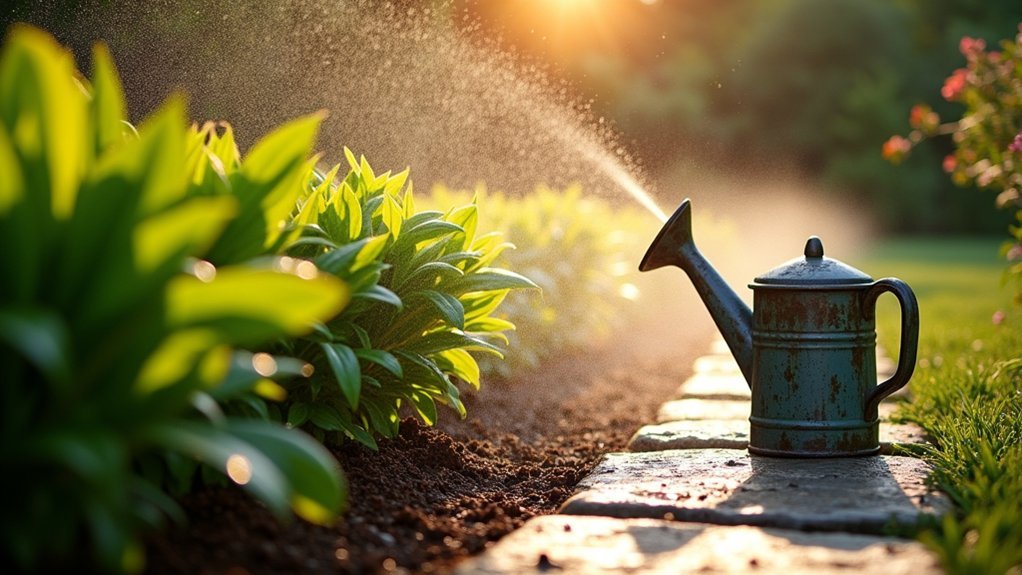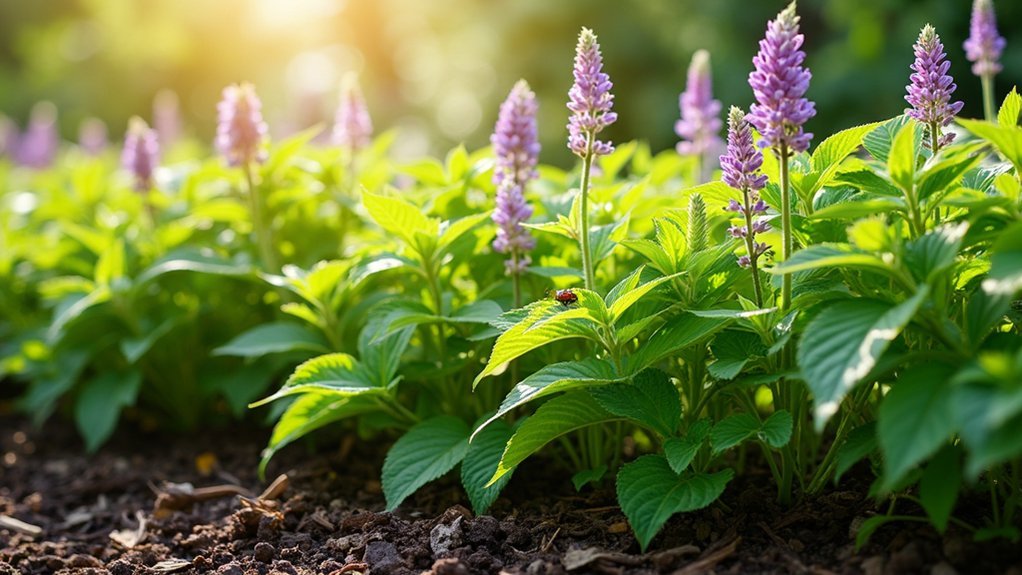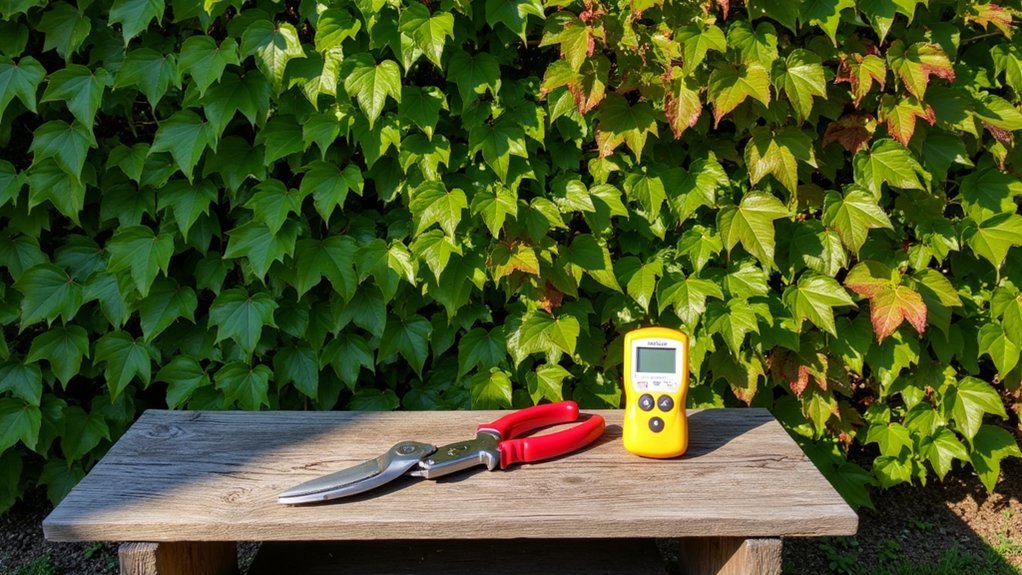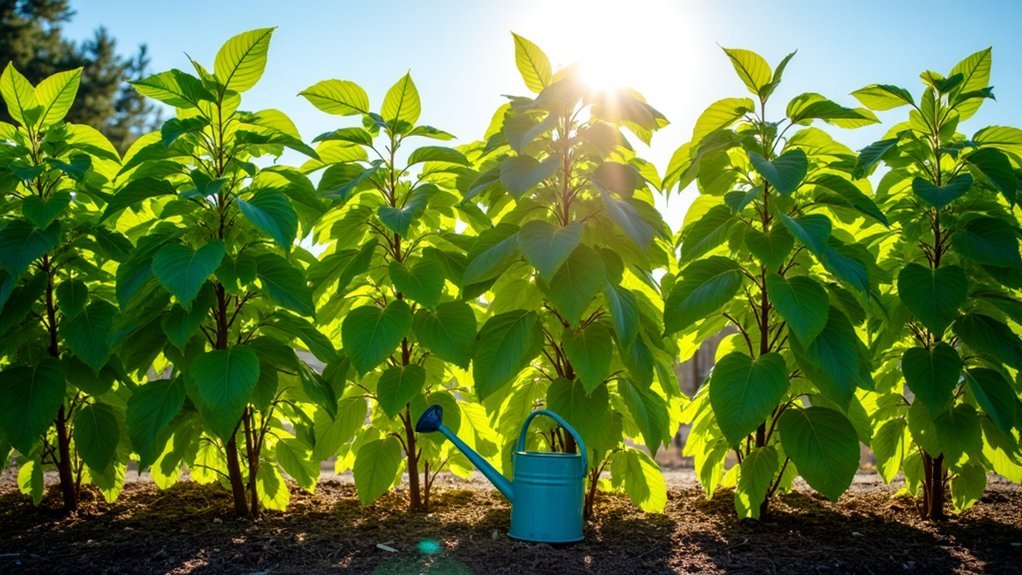To keep your living fence thriving in summer, water deeply before 10AM, 2-3 times weekly during extreme heat. Apply 2-3 inches of organic mulch, keeping it away from stems to retain moisture. Limit pruning to light shaping and damaged branch removal during peak heat. Use natural pest deterrents like chili pepper spray and companion planting. Regularly inspect for stress signs and address issues promptly. These simple practices will transform your living barrier into a resilient, vibrant boundary.
Proper Watering Techniques During Heat Waves

When summer temperatures soar, your living fence requires special attention to prevent stress and dehydration. Water deeply before 10 AM when evaporation rates are lowest, ensuring moisture reaches the root zone where it’s most needed.
Check soil moisture daily by inserting your finger 2-3 inches deep. During extreme heat, you’ll need to water established hedge plants 2-3 times weekly.
Install drip irrigation or soaker hoses for efficient delivery directly to roots, avoiding wasteful sprinklers.
Apply 2-4 inches of organic mulch around your living fence to retain moisture and regulate soil temperature. Create small basins around plants to direct water where it’s needed. Regular removal of competing weeds will help ensure your living fence receives maximum available moisture.
For newly planted sections, provide more frequent watering and consider temporary shade cloth to reduce water loss during the hottest days.
Essential Summer Pruning Strategies
Although many gardeners focus on watering during hot months, proper pruning remains equally critical for maintaining healthy living fences throughout summer. You’ll need to time your pruning carefully to avoid stressing plants during extreme heat. Opt for early morning sessions with the right tools for your specific fence type. Regular pruning creates a cohesive structure for living fences that enhances both their functionality and appearance.
| Timing | Technique | Benefits |
|---|---|---|
| Early Summer | Light shaping cuts | Maintains form without stress |
| Mid-Summer | Minimal intervention | Prevents heat-related damage |
| Late Summer | Selective thinning | Improves air circulation |
Remember to avoid heavy pruning during peak heat. Instead, focus on removing damaged branches and maintaining uniformity through targeted cuts. This approach promotes bushy growth while preventing your fence from becoming top-heavy, ensuring sunlight reaches lower sections.
Organic Pest Prevention for Thriving Barriers

Living fences face numerous pest challenges during summer months, yet chemical pesticides can damage the beneficial insects that help maintain ecological balance.
Instead, embrace natural solutions that protect your living barriers while preserving their ecosystem.
Create a defensive strategy with these organic approaches:
- Attract beneficial predators by planting nectar-rich flowers nearby and installing insect hotels to house ladybugs, lacewings, and parasitic wasps that naturally control pest populations. The success of a wild jungle barrier demonstrates how biodiversity can create a self-sustaining ecosystem that manages pests naturally.
- Apply homemade deterrents like chili pepper spray for mammals or soapy water solutions for insects, reapplying after rainfall for consistent protection.
- Implement physical barriers such as protective trunk guards, netting, and copper tape to block pests without chemicals, while companion planting aromatic herbs to confuse and repel unwanted visitors.
Mulching Methods for Moisture Retention
Maintaining adequate moisture around your living fence during hot summer months can determine its survival and vigor.
Apply a 2-3 inch layer of organic mulch around your living fence, keeping it 1-2 inches away from stems to prevent rot.
For ideal results, choose the right mulch type. Wood chips reduce watering needs by up to 40%, while straw mulch decreases evaporation by 65% compared to bare soil.
Bark mulch excels at heat insulation, and leaf mulch provides cost-effective protection. The organic matter will gradually build better soil as it decomposes over time.
Apply mulch immediately after soil preparation and refresh it mid-season if decomposition is noticeable.
You’ll need to water less frequently, as proper mulching acts as a protective barrier against evaporation and erosion while suppressing weeds and stabilizing soil temperature.
Monitoring and Repairing Heat-Stressed Sections

Heat stress can silently damage your living fence during summer’s peak temperatures, making regular monitoring essential for long-term health.
Summer heat silently attacks fences, requiring vigilant inspection to ensure lasting durability and structural integrity.
Watch for warping boards, loosened fasteners, and signs of post instability in your fence structure. These issues worsen quickly if left unaddressed. Frost heave effects can be magnified during summer as soil rapidly expands and contracts with moisture changes.
When you spot damage, act promptly with these targeted repairs:
- Reinforce unstable posts using fast-setting concrete and crushed stone to create a solid foundation
- Replace damaged sections before they compromise your entire fence structure
- Apply protective treatments such as UV-resistant coatings to prevent future damage from sun exposure
For prevention, maintain proper soil moisture around posts and consider adding strategic plantings to provide natural shade for your fence during intense afternoon heat.
Frequently Asked Questions
Can Living Fences Provide Cooling Effects for Nearby Structures?
Yes, living fences cool nearby structures through transpiration, reducing ambient temperatures by 1-3°C. They’ll create shade, block hot winds, and form cooler microclimates that minimize heat absorption and lower your building’s energy consumption.
How Do Summer Fertilization Needs Differ From Other Seasons?
You’ll need less fertilizer in summer compared to spring. Focus on watering instead, as over-fertilizing during hot months can stress plants. Only add nutrients if your soil is poor or growth seems stunted.
Should I Alter Maintenance for Newly Established Versus Mature Living Fences?
Yes, you’ll need different approaches for each stage. New fences require more frequent watering, regular pruning, and support systems, while mature fences need less water and only occasional pruning for maintenance.
Are There Companion Plants That Strengthen Summer Fence Resilience?
Yes, you’ll boost fence resilience with lavender and rosemary to deter pests, clover to fix nitrogen, ornamental switchgrass for wind protection, and butterfly bush to support pollinators. These companions create a healthier ecosystem around your fence.
What Wind Protection Measures Help Living Fences During Summer Storms?
Plant windbreak shrubs in front of your living fence, install lattice barriers, and maintain gaps between pickets. You’ll strengthen your fence’s resilience during summer storms by allowing wind to pass through rather than push against it.
In Summary
Your living fence deserves special attention during summer’s harsh conditions. By implementing these five care strategies—proper watering during heat waves, timely pruning, organic pest management, effective mulching, and regular monitoring—you’ll maintain a healthy, vibrant barrier throughout the hottest months. Remember, your fence isn’t just a boundary; it’s a living ecosystem that rewards your careful summer maintenance with years of natural beauty and functionality.





Leave a Reply